Martin Marietta Coordinates for Success on College Avenue Project in Fort Collins
BY AsphaltPro Staff
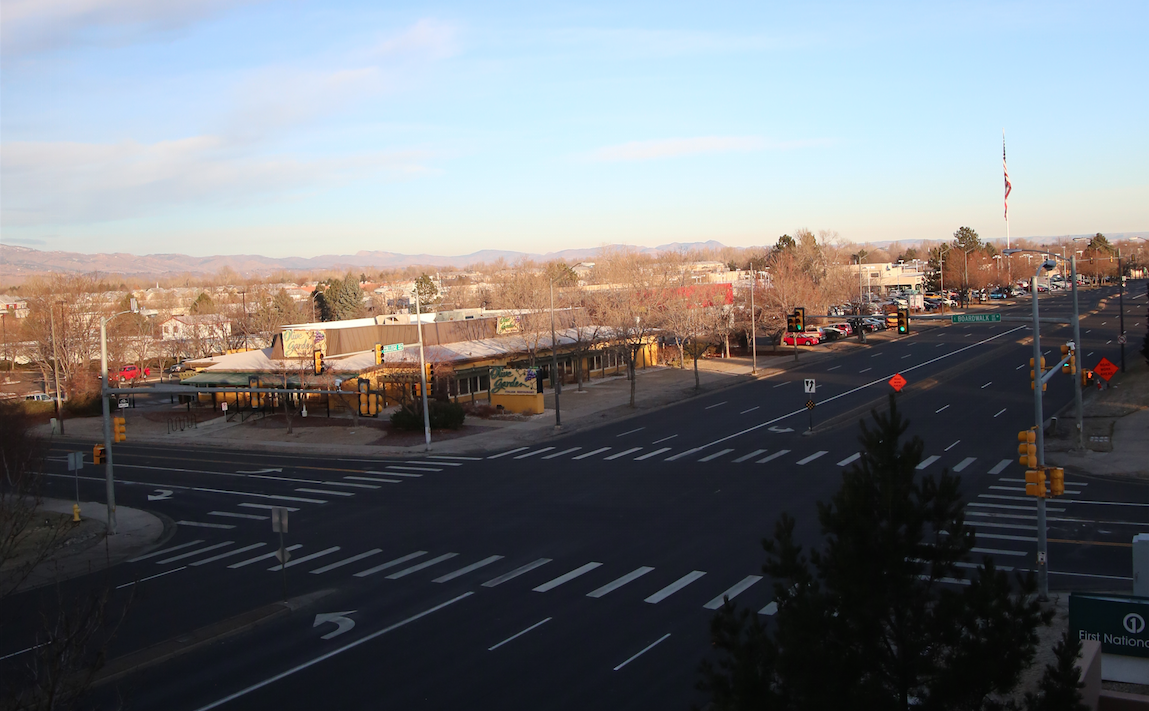
Most jobs require a certain level of coordination—among crewmembers, with the plant, with the client, etc. Martin Marietta took effective coordination to a whole new level with a recent project along College Avenue in Fort Collins, Colorado, and its hard work paid off: the project won this year’s Urban Highway Resurfacing Award from the Colorado Asphalt Paving Association.
The $8.9 million project, completed in October of 2016, required a wide range of work on a four-mile stretch of College Avenue, a main thoroughfare through Fort Collins. With three lanes of traffic headed both north- and southbound, the project ultimately amounted to 24 lane miles of work and 33,700 tons of mix.
The project was completed by Martin Marietta’s Northern Asphalt and Paving Group, and incorporated materials produced by the company’s aggregates group, ready mix group, and asphalt production and paving groups. In its northern division, alone, the company employs around 130 hourly employees during paving season. According to Martin Marietta Project Manager Ken Carter, 40 or 50 of those employees spent at least some time on this project, including two 12-person paving crews, 10 truck drivers, two four-man crews to grade and place the aggregate base course, three quality control personnel to ensure quality mix, and a six-person asphalt patching crew.
“One cool thing about this project is we used aggregates mined by Martin Marietta for both the concrete and asphalt used on this project,” Carter said. Although Martin Marietta’s work ranges from private work to small commercial and large residential work, about 20 or 30 percent of the north group’s work is with CDOT.
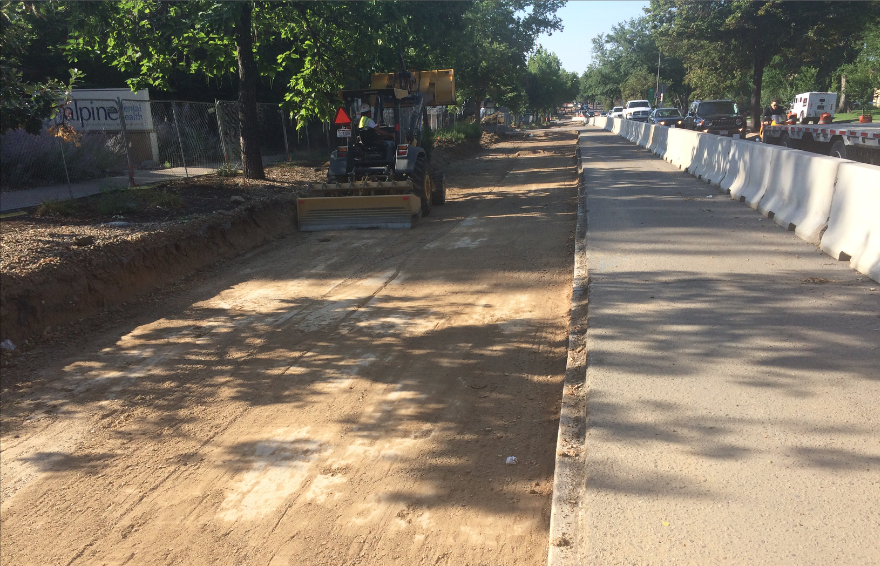
Prior to placing the base course in the FDR section, the crew had to grade the area, as you see here. You can also see the 6-foot steel fence the crew had to use to better control the heavily trafficked pedestrian areas.
The Process Behind the Project
“The last time the road had been overlaid was about 20 years ago and it was showing a lot of distress,” Carter said. “Water is obviously the biggest threat to asphalt, and Fort Collins receives over 50 inches of snow every year. Moisture from snow and ice, as well as potential damage from the snow plowing process, takes its toll on pavement in Fort Collins.”
According to CDOT records, that section of the roadway was paved in December of 1997, when it had 1.5 inches of material milled off and 2 inches of HMA placed.
The first phase of the project required concrete rehabilitation along the corridor, including curb and gutter replacement, sidewalk replacement, and handicap access ramps. Then, the crew focused its attention to two bridges that needed to be rehabilitated and retrofitted to bring them up to modern standards. The final portion of the project—a ¾-mile stretch on the northern section of College Avenue—required full-depth reclamation.
To do so, the crew needed to remove the existing 3-to-5 inch asphalt overlay, as well as the 6-inch thick concrete panels underneath. “These removals allowed us to correct the roadway’s cross slope and install new curb and gutter to improve the drainage in this section of roadway,” Carter said. The removals also created the necessary space for the placement of a 6-inch aggregate base course, installation of 6 inches of new asphalt, and the placement of new curb and gutter that tied into the existing storm drain system. “There were some flood zones along that stretch, so we really had to make sure to get the drainage right.”
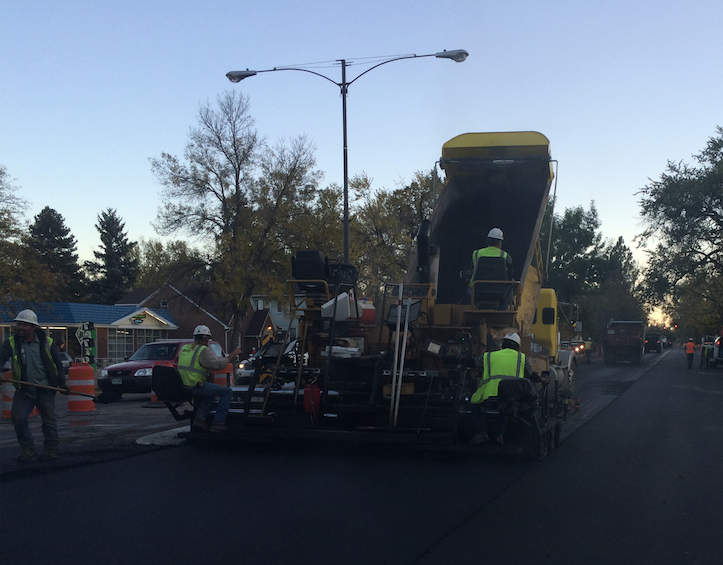
All of the paving for this project was completed at night. Although the south end of the project was quiet at night, the north portion of the project ran through the busy bar and restaurant district.
When it came time to lay its mix, the crew used 2,500 tons to patch areas prior to milling. Carter gives a lot of credit for the job’s results on mix quality to the company quality control process and personnel.
Then it was time to mill off three inches of existing asphalt. Although Martin Marietta subcontracted its milling work to Don Kehn Construction, Fort Collins, Colo., the crew still had to ensure it met the state’s macro texture testing.
“CDOT really emphasized the quality of milling prior to paving, so we really had to make sure we were milling within specifications,” Carter said. “We had to set ourselves up with a strong foundation to pave on.”
“[Don Kehn Construction] did a great job making sure to correct the grade and get the drainage right,” Carter said.
After the milling was complete, the crew laid a 1-inch non-polymer leveling course with PG64-22 binder—a full 14,00 tons—and then performed a 2-inch overlay with PG64-28 that required 19,700 tons of mix. Both mixes had a nominal maximum aggregate size of 1/2-inch, and the production temperature of the mix was 325 degrees Fahrenheit, and the laydown temperature, 290. The crew used a Cat 1055D for its mainline paving and a Weiler P385 for turn lanes. Using a separate paver for the turn lanes made it so the crew didn’t need to unhook its Barber Green 650 windrow elevator from its Cat paver.
To compact the job, the crew used three Cat steel drum rollers and a Sakai rubber tire roller.
Ultimately, Martin Marietta’s crew was able to reduce this stretch of the road’s HRI from a 140 to a 70, despite working around 57 manholes and 64 water valves.
“CDOT requires all manholes and water valves to be lowered below the milling grade,” Carter said. To meet that requirement, Martin Marietta removed the top sections of each water valve and manhole, placed steel plates over them and patched with asphalt before milling, paving and then raising and adjusting each utility to its final grade. “The target is ¼-inch below the final grade to keep snow plows from damaging the utility.”
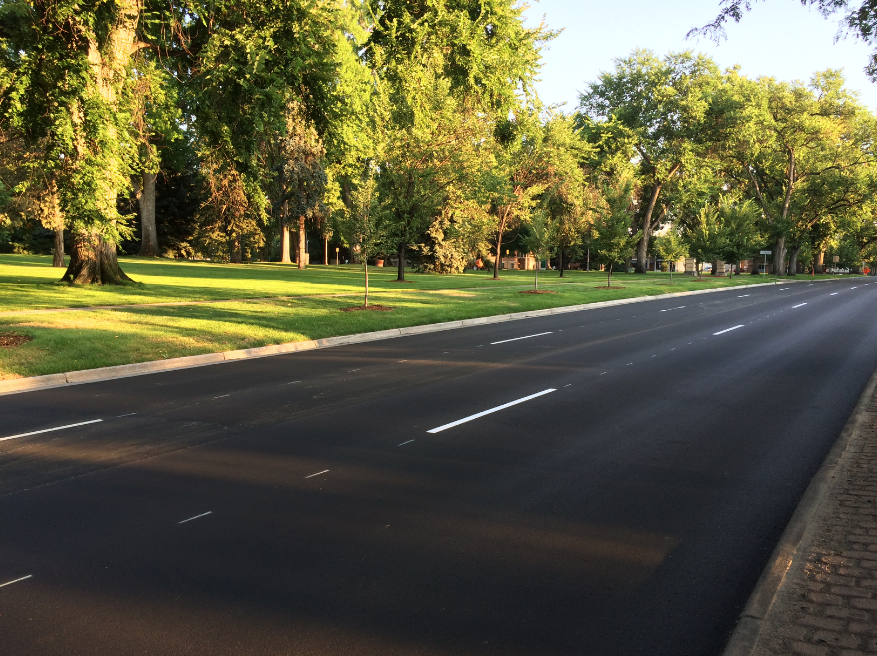
The $8.9 million project was completed in October of 2016 and ultimately amounted to 24 lane miles of work and 33,700 tons of mix.
Work With Many Stakeholders
Although this was a CDOT project, the city of Fort Collins is responsible for maintenance along this particular stretch of road. “For example, they wanted to add additional areas of concrete rehab to the project, so we had to make sure to get out ahead of those changes so they wouldn’t affect our paving plans or schedule.”
Additionally, CDOT didn’t have its own manager on-site, but contracted with Parsons Engineering Group.
“That gave us an extra level of coordination and planning,” Carter said. “When we had plan changes, we’d communicate with Parsons and they would take it back to CDOT.”
And, with the project running in front of Colorado State University, which had its own projects going on, the job required a lot of coordination between groups. In fact, Carter presented at the 44th annual Rocky Mountain Asphalt Conference and Expo about partnering for success, based on his experience on this project.
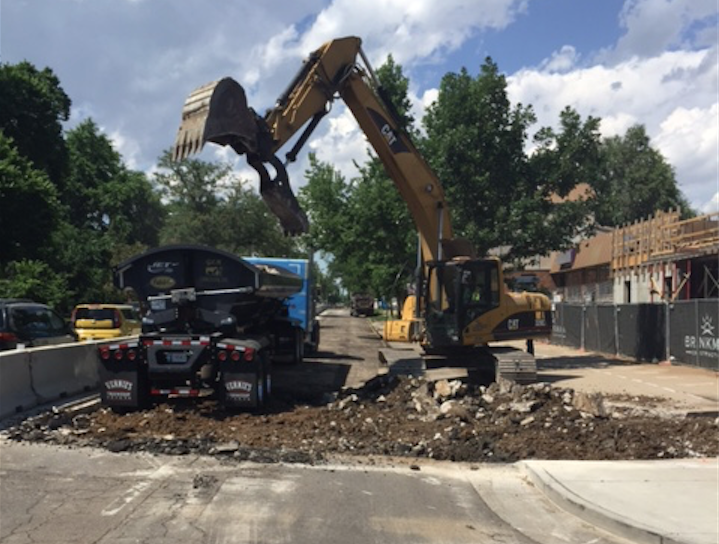
The crew had to remove 3-to-5 inches of asphalt overlay, as well as 6-inch-thick concrete panels underneath, as you see here.
“CDOT had input, Parsons had input, the city had input, CSU had input, plus the economic pressures of the business owners…It wasn’t bad, but it did require a lot of coordination,” Carter said. To work effectively with the many stakeholders, there were weekly meetings to coordinate schedules and discuss upcoming issues. For example, the city planned another road construction project east of Martin Marietta’s job that required a detour on College Avenue. To ensure better traffic flow, CDOT approved a plan from Martin Marietta to start its bridge work one month earlier than originally planned so College Avenue would be ready to accept the additional traffic generated from the city’s project. Martin Marietta’s Paving Superintendent Jed Foust was also sure to have very solid daily paving plans so everyone could be kept in the loop.
To keep the public and area business owners aware, Martin Marietta held a public outreach meeting with all stakeholders and the general public ahead of the project and hired public information company Merge Resource Group to distribute updates about the project throughout its duration, including information on CDOT’s website, a project-specific website, social media posts, and e-blasts of upcoming lane closures.
One interesting component of this project was the variety of businesses and buildings alongside the road. The south end of the project ran along big box stores and the local mall. Then it runs through a residential area and ends in the older part of town, right in front of Colorado State University, with many bars and restaurants active well into the night.
“When we paved [at night] in the southern part, we had very little traffic,” Foust said. “We had no trouble getting the trucks in and out.”
The north end was an entirely different story. Not only did the lanes get narrower in the northern part of the project, but the crew had to contend with a lot of pedestrian traffic, crossing from the restaurants and bars on the east side of the road to the dorms and campus on the west side of the road.
“We actually had to apply some of our internal safety practices to outside society, not just our crew who know what they’re doing,” Foust said. CDOT helped out by providing more flaggers to control traffic, especially pedestrian traffic at intersections. Those special considerations also required a change order to replace the planned plastic safety fence along the FDR portion of the project with a sturdier 6-foot steel fence. “That plastic fence wasn’t cutting it for controlling pedestrian traffic.”
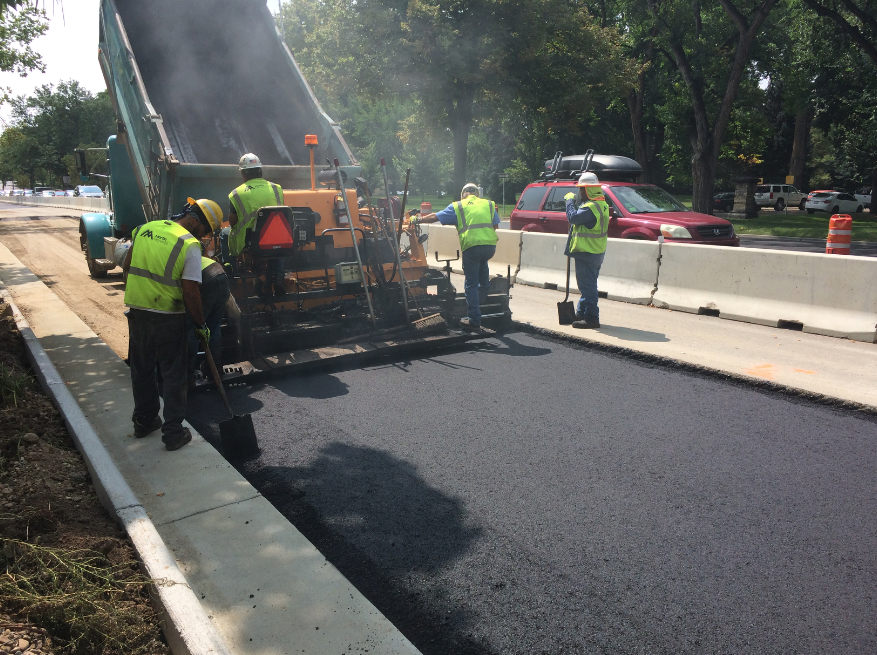
In the section where the crew had to complete a full-depth reclamation, you can see them paving 6 inches of asphalt over a 6-inch base here.
The concrete rehabilitation and bridgework occurred during the day, and the paving, at night. “That required a bit of discussion to make sure we transitioned from team to team and everyone knew what they needed to do every day and every night,” Carter said, adding that it came down to the crew working hard and knowing its stuff.
“A core strength of our operation here are the people,” Carter said. “Some of the guys on our crews have been here 40 years. We wouldn’t have had as successful of a job if we didn’t have great employees.”
According to Carter, many of the crew members on this job were actually on the crew that paved this stretch of College Avenue 20 years ago, for a different company.
“It was interesting to see them take ownership of how long their work lasted,” Carter said. “There was a lot of pride on this project. They live here and they want to see it last another 20 years.”
